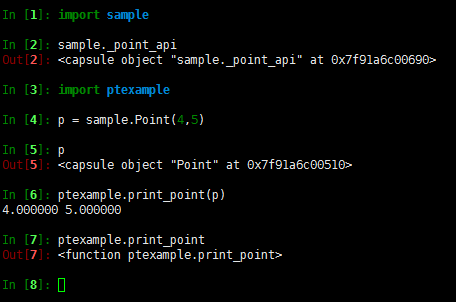
一、C层面模块添加API
我们仍然操作如下结构体,
#include <math.h>
typedef struct Point {
double x,y;
} Point;
本节目标是封装两个Point结构体的操作函数为sample库的C级API,可以被sample以外的C库调用,首先写出以下函数指针结构体实例,
/* pysample.c */
static PyObject *PyPoint_FromPoint(Point *p, int must_free) {
/* 胶囊和C指针类似。在内部,它们获取一个通用指针和一个名称,可以使用
PyCapsule_New() 函数很容易的被创建。 另外,一个可选的析构函数能被
绑定到胶囊上,用来在胶囊对象被垃圾回收时释放底层的内存*/
return PyCapsule_New(p, "Point", must_free ? del_Point : NULL);
}
/* Utility functions */
static Point *PyPoint_AsPoint(PyObject *obj) {
return (Point *) PyCapsule_GetPointer(obj, "Point");
}
static _PointAPIMethods _point_api = {
PyPoint_AsPoint,
PyPoint_FromPoint
};
结构体定义如下,位于一个新的头函数中,
/* pysample.h */
/* Public API Table */
/* 这里最重要的部分是函数指针表 _PointAPIMethods.
它会在导出模块时被初始化,然后导入模块时被查找到。 */
typedef struct {
Point *(*aspoint)(PyObject *);
PyObject *(*frompoint)(Point *, int);
} _PointAPIMethods;
修改初始化函数,将函数指针结构体注册为Capsule,并将之使用PyModule_AddObject,添加给模块对象,作为模块属性,
PyModule_AddObject(PyObject *module, const char *name, PyObject *value),其中module就是Py_InitModule()返回的对象,含义就是将py_point_api这个类加入m这个模块中,并简记为"_point_api"。
/* pysample.c */
/* Module initialization function */
PyMODINIT_FUNC
PyInit_sample(void) {
PyObject *m;
PyObject *py_point_api;
m = PyModule_Create(&samplemodule);
if (m == NULL)
return NULL;
/* Add the Point C API functions */
py_point_api = PyCapsule_New((void *) &_point_api, "sample._point_api", NULL); //<---pysample.h:23,name为全名
if (py_point_api) {
PyModule_AddObject(m, "_point_api", py_point_api); //name略去模块名
}
return m;
}
测试如下,

不过由于Python并不能解析Capsule对象,所以这个API实际上是留给其他C源代码调用的。
我们希望在调用这个Capsule对象时,并不直接导入这个C源文件,只是使用头文件,所以我们在pysample.h中再进行一次封装,
/* pysample.h */
/* Method table in external module */
static _PointAPIMethods *_point_api = 0;
/* Import the API table from sample, import_sample() 被用来指向胶囊导入并初始化这个指针 */
static int import_sample(void) { //<---ptexample.c:46
// 需提供属性名(比如sample._point_api),会一次性找到胶囊对象并提取出指针来。
_point_api = (_PointAPIMethods *) PyCapsule_Import("sample._point_api",0); //<---pysample.c:171
return (_point_api != NULL) ? 1 : 0;
}
/* Macros to implement the programming interface */
#define PyPoint_AsPoint(obj) (_point_api->aspoint)(obj)
#define PyPoint_FromPoint(obj) (_point_api->frompoint)(obj)
PyCapsule_Import:从模块中的capsule属性导入指向C对象的指针。 name 参数应指定属性的全名,如 module.attribute 中所示。存储在胶囊中的 name 必须与该字符串完全匹配。
此时我们就已经封装好了pysample.c中的两个函数为PyPoint_AsPoint和PyPoint_FromPoint,可以接受任何导入了pysample.h的文件使用。
小结
- 将函数指针封装到结构体中
- 将结构体生成为Capsule,并将其作为属性绑定给模块
- 使用PyCapsule_Import根据模块名称检索到Capsule,由于该函数会直接返回C指针,直接使用一个空的结构体接受Capsule即可
二、C层面模块调用API
/* ptexample.c */
/* Include the header associated with the other module */
#include "pysample.h"
/* An extension function that uses the exported API */
static PyObject *print_point(PyObject *self, PyObject *args) {
PyObject *obj;
Point *p;
if (!PyArg_ParseTuple(args,"O", &obj)) {
return NULL;
}
/* Note: This is defined in a different module */
p = PyPoint_AsPoint(obj);
if (!p) {
return NULL;
}
printf("%f %f
", p->x, p->y);
return Py_BuildValue("");
}
static PyMethodDef PtExampleMethods[] = {
{"print_point", print_point, METH_VARARGS, "output a point"},
{ NULL, NULL, 0, NULL}
};
static struct PyModuleDef ptexamplemodule = {
PyModuleDef_HEAD_INIT,
"ptexample", /* name of module */
"A module that imports an API", /* Doc string (may be NULL) */
-1, /* Size of per-interpreter state or -1 */
PtExampleMethods /* Method table */
};
/* Module initialization function */
PyMODINIT_FUNC
PyInit_ptexample(void) {
PyObject *m;
m = PyModule_Create(&ptexamplemodule);
if (m == NULL)
return NULL;
/* Import sample, loading its API functions */
if (!import_sample()) { //<---pysample.h:21
return NULL;
}
return m;
}
这里面先初始化前面.h文件中的指针,然后接收调用。
测试如下,
